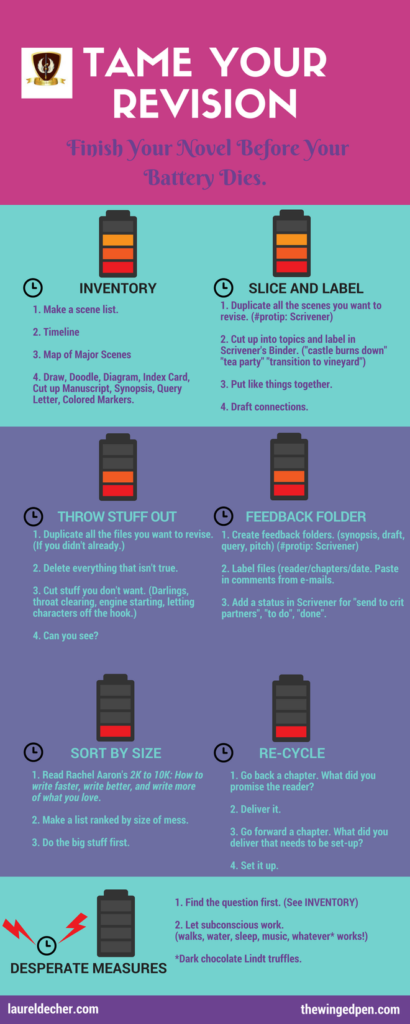
This TAME YOUR REVISION series started over at The Winged Pen.
Here are links to the individual posts:
- Inventory
- Slice and Label With Scrivener
- Throw Stuff Out–There’s no separate post for this one. Everything I have to say is on the infographic. 🙂
- Feedback Folder
- Sort By Size
- Re-Cycle
- Desperate Measures
You can download the infographic.
As always, feel free to share your best revision strategies in the comments! I’d love to know how you manage.
Public Service Announcement: Yesterday, my husband quoted a new study showing that cycling to work cuts your risk of death in half.
So, bike, writers, bike! 🙂
If you don’t have a commute (you lucky dogs!) you can also reduce your risk of chronic disease and death by walking two hours a week (six miles). The important thing is to keep moving daily. A half hour per day will get your creative juices going and may just save your life.
End of epidemiologist’s soapbox. 😉
“A story has a beginning, a middle, and an end.*” What does that even mean? This whole concept sailed over my head for YEARS until I realized it means:
A story sets up the worst possible scenario for a character, makes it worse in every possible way until the whole situation explodes, and then ties most of the loose ends together to make it satisfyingly tidy.
*Those of you who don’t overcomplicate everything were perfectly happy with the first statement. Thanks for your patience!
CYCLING is a simple way to set traps for readers to incorporate story structure into your novel. Many brilliant people have written about story structure and how to use it elsewhere*.
*Need to read up on story structure? Try Blake Snyder’s classic and breezy SAVE THE CAT (start with chapter 4). Or watch Dan Wells’ inviting and efficient series of videos.
Dan Wells gave an excellent revision workshop that began with a deceptively simple question to organize your whole revision: “Did you meet your goals?”
i.e. What did you want to do when you set out to write this book? Make your best friend laugh? Puzzle people with an intricate mystery? Dueling characters with dazzling reparteé?
If you know what you want to do, you can get help to do it better. I wasted a lot of time thinking that the experts were going to tell me what my manuscript was about. I think I thought agents had x-ray vision.
Don’t despair! Dan says: If you didn’t have a purpose before you started drafting, you need to find a purpose afterwards and impose it. This is when you get to cherry pick what makes a great story.
Cycling is the same idea on a smaller scale.
CYCLE
- Go back a chapter. What did you promise the reader? Read through the chapter and make a list of every hint you dropped. If you’re like me, you’ll be surprised how many you find. Cut the hints that don’t line up with your story purpose.
- Deliver it. Find a place in the manuscript to give the thing you promised. The disaster that was hidden in the sidekick’s throwaway comment.
- Go forward a chapter. What did you deliver that needs to be set-up? Check the big scenes where the hero overcomes the evil villain, the girl gets the boy, or the child saves the day. Make a list of the feelings you want to give the reader.
- Set it up. Find places in the manuscript to hint at what’s coming. Seed some doubt. Give another reason why it matters. Get the reader just where you want them.
Happy revising!
Did you find this helpful? I’m always collecting new ways to solve my story problems. What easy ways do you build more into your stories?
Save
Save
